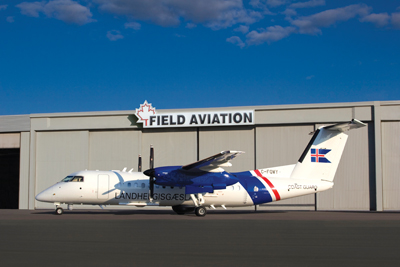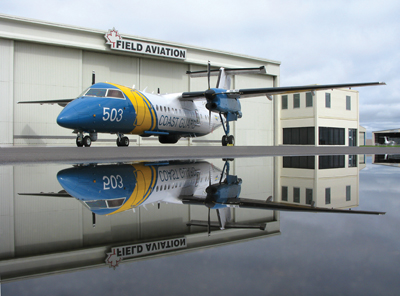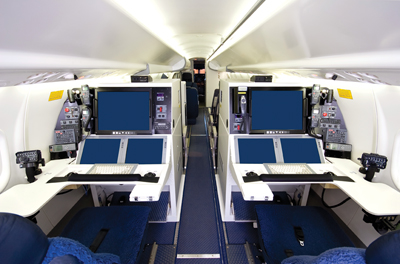
Features
MRO
Taking Canada’s Best to the World
When you discuss aircraft modifications and innovation, a Canadian name continually comes up around the world – Field Aviation. The company has set the standard in so many unique and special mission applications that it has become a leader in the field.
September 29, 2009 By Rob Seaman
When you discuss aircraft modifications and innovation, a Canadian name continually comes up around the world – Field Aviation. The company has set the standard in so many unique and special mission applications that it has become a leader in the field.
 |
|
| The handover of the first Dash 8 Q300, specifically developed into a maritime surveillance aircraft (MSA) for the Icelandic Coast Guard took place on June 26, 2009.
|
If you do something long enough you become pretty good at it. Field has been in the aviation business for 60 years; that represents a lot of experience in repairing, modifying, maintaining and refinishing regional, commercial, corporate and special missions aircraft. With its head office operation in Toronto and a second facility in Calgary, it has also developed strategic partnerships around the world – all with the focus of supporting and sustaining the work it does for a global base of clientele.
Originality and “imagineering” are words that come to mind when you look at Field’s track record – from management and administration, through to its top-rated aviation engineering, maintenance and repair specialists. That said, the Field we see today is a very different company and organization from the one that existed a little over a year ago. According to Joar Gronlund, chief operating officer of Field Aviation Company Inc., its internal focus is now on special mission aircraft modifications “but we also recognize that the unique skills that we possess in order to successfully take on a large aircraft modification program give us capabilities in many related areas that provide their own business opportunities.” This, according to Gronlund, includes engineering services together with flight tests and analyses, aircraft conversions and interior reconfigurations, avionics sales and service, avionics and systems modifications, aircraft parts manufacturing, new aircraft sales for Hawker Beechcraft and pre-owned brokerage as well as aircraft maintenance in support of modifications. “We see all of this as positive developments,” he concludes.
Why the change? According to Gronlund, prior to the reorganization, Field Aviation pursued a range of different aviation related activities without, as he puts it, “necessarily achieving synergy in all of these.” He continues by stating that “remaining competitive and growing, the company became difficult when trying to cover all or most of the bases and drew management attention away from the markets that provided real growth opportunities.” That is the logic and reason behind Field deciding that it would no longer pursue the commercial and military MRO business in Calgary. The company reorganized to focus on aircraft modifications and those related aviation activities where it can “achieve synergy” and the cross utilization of key resources.
 |
|
| Field Aviation’s modified Dash 8 Q300 MSAs for the Swedish Coast Guard were delivered in 2008.
|
Change rarely comes easily but once Field got over the agony of reducing personnel to the appropriate size for the market focus, then the reorganization had a very clear and positive impact on the entire staff. Today, Gronlund states, “the direction of the company is visible to all staff; it makes sense, communication is easier and everybody has shared with enthusiasm and pride the successes they have had.”
Part of the evolution involved some significant leadership and organization changes. The new management team, with the exception of the new president and CEO, is entirely made up of people who were with Field Aviation at the time of the reorganization, and predominantly with similar roles and responsibilities. The company reports that the organizational change has been very successful, but no company can survive unless there is willingness to grow and adjust, so there is still some fine tuning going on.
The Calgary operation underwent the most visible and outwardly apparent change. Today, there are two significant capabilities that were retained in Calgary. The first is the group within its engineering organization that primarily focuses on the design of aircraft interior changes – whether those are for stand-alone projects or are part of a larger project. Second is the parts manufacturing activity, which started off in the late ’80s by producing parts for “out of production” de Havilland aircraft under licence, and has since grown to produce parts for current Bombardier aircraft as well as for other customers. There is also an administration element to support the local operations. Today there are still around 100 employees in Calgary and approximately 300 overall within Field.
One of the first projects to roll out from this new and revised Field Aviation was recently unveiled in Toronto. On June 26, approximately 150 invited dignitaries, industry guests and employees turned out to witness the handover of the first Dash 8 Q300, specifically developed into a maritime surveillance aircraft (MSA) for the Icelandic Coast Guard. Attendees included Her Excellency Iceland’s Ambassador to Canada, Ms. Sigridur Anna Thordardottir and Georg Larusson, Director General of the Icelandic Coast Guard.
Field was the prime contractor and integrator on the project – valued at more than 30 million dollars. They partnered with Bombardier Aerospace (who supplied the basic Dash 8 Q300 aircraft) and L-3 Communications (who supplied the selected sensor systems). The basic Dash 8 Q300 was first equipped for long-range fuel and an auxiliary power unit, enabling it to perform missions of more eight hours endurance.
 |
|
| The large cabin interior, coupled with the Q300’s proprietary Active Noise and Vibration system will provide a comfortable and state-of-the-art working environment.
|
Field also outfitted the aircraft with Maritime Search Radar, Side Looking Radar (SLAR) and an Electro–Optical/Infra-Red pod (FLIR). All sensors feed into an integrated data handling system supplied by L-3 Communications. Field also handled the integration of the surveillance systems into the aircraft and designed and built a new interior. As part of its mod, it designed and approved an in-flight operable door that will allow crews to deploy location flares and paradrop personnel, oil sampling buoys, and larger items such as inflatable rafts, all while on active mission patrol.
The Icelandic Dash 8 Q300 MSA has multi-mission capabilities, including search and rescue, maritime sovereignty, medevac and other first response activities. The aircraft’s speed and endurance capabilities will provide for shorter transit times and more on station capability in replacing the Icelandic Coast Guard’s current maritime aircraft. This will allow the Coast Guard to increase both environmental and fisheries surveillance as well as perform customs duties and border protection. The large cabin interior, coupled with the Q300’s proprietary Active Noise and Vibration system will provide a comfortable and state-of-the-art working environment for the Coast Guard crews on board.
Field has been in the MSA and maritime patrol mod business now since 1996. Previous clients are from Australia, the U.S. Customs and Border Protection, the Japanese Coast Guard and the Swedish Coast Guard. One key note of interest is that the Icelandic Coast Guard MSA has a configuration based on the Field Aviation modified Dash 8 Q300 MSAs for the Swedish Coast Guard delivered in 2008. The similarity of type and equipment will provide international cost-sharing opportunities as well as operational, maintenance, training and support synergies for both countries.
From its simple start in 1947 at Oshawa where it began by providing maintenance support to Kenting Aviation, Field has grown and evolved to be a recognized “name.” It is proudly Canadian and looks to continue flying the flag and set new standards for years to come. As for the future – Field is not putting away the book on its surveillance and rescue mods any time soon. More orders are on the books!